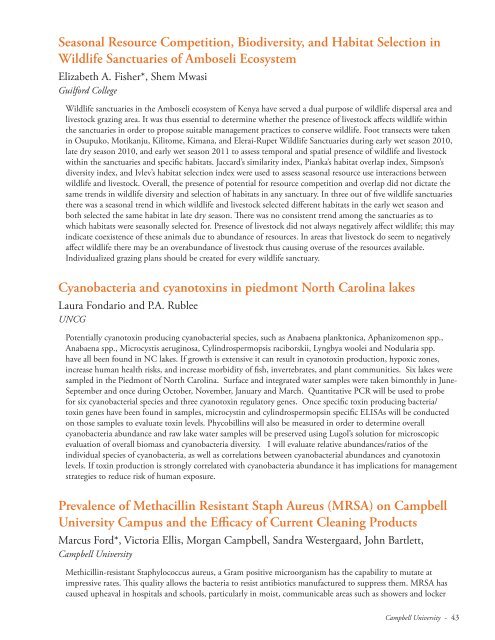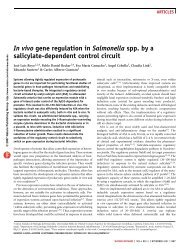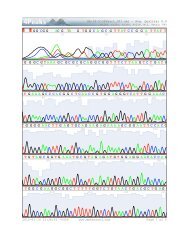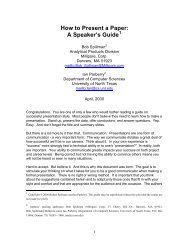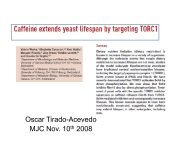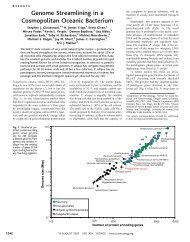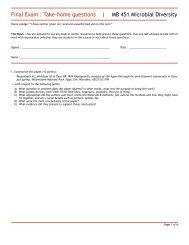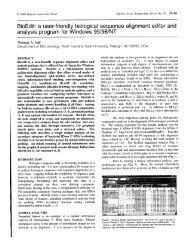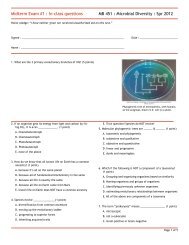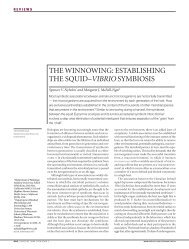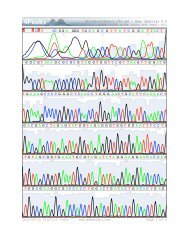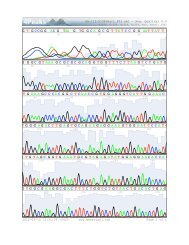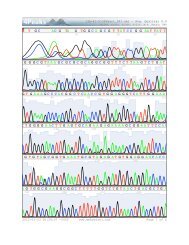Schedule and Program - North Carolina Academy of Science
Schedule and Program - North Carolina Academy of Science
Schedule and Program - North Carolina Academy of Science
Create successful ePaper yourself
Turn your PDF publications into a flip-book with our unique Google optimized e-Paper software.
Seasonal Resource Competition, Biodiversity, <strong>and</strong> Habitat Selection inWildlife Sanctuaries <strong>of</strong> Amboseli EcosystemElizabeth A. Fisher*, Shem MwasiGuilford CollegeWildlife sanctuaries in the Amboseli ecosystem <strong>of</strong> Kenya have served a dual purpose <strong>of</strong> wildlife dispersal area <strong>and</strong>livestock grazing area. It was thus essential to determine whether the presence <strong>of</strong> livestock affects wildlife withinthe sanctuaries in order to propose suitable management practices to conserve wildlife. Foot transects were takenin Osupuko, Motikanju, Kilitome, Kimana, <strong>and</strong> Elerai-Rupet Wildlife Sanctuaries during early wet season 2010,late dry season 2010, <strong>and</strong> early wet season 2011 to assess temporal <strong>and</strong> spatial presence <strong>of</strong> wildlife <strong>and</strong> livestockwithin the sanctuaries <strong>and</strong> specific habitats. Jaccard’s similarity index, Pianka’s habitat overlap index, Simpson’sdiversity index, <strong>and</strong> Ivlev’s habitat selection index were used to assess seasonal resource use interactions betweenwildlife <strong>and</strong> livestock. Overall, the presence <strong>of</strong> potential for resource competition <strong>and</strong> overlap did not dictate thesame trends in wildlife diversity <strong>and</strong> selection <strong>of</strong> habitats in any sanctuary. In three out <strong>of</strong> five wildlife sanctuariesthere was a seasonal trend in which wildlife <strong>and</strong> livestock selected different habitats in the early wet season <strong>and</strong>both selected the same habitat in late dry season. There was no consistent trend among the sanctuaries as towhich habitats were seasonally selected for. Presence <strong>of</strong> livestock did not always negatively affect wildlife; this mayindicate coexistence <strong>of</strong> these animals due to abundance <strong>of</strong> resources. In areas that livestock do seem to negativelyaffect wildlife there may be an overabundance <strong>of</strong> livestock thus causing overuse <strong>of</strong> the resources available.Individualized grazing plans should be created for every wildlife sanctuary.Cyanobacteria <strong>and</strong> cyanotoxins in piedmont <strong>North</strong> <strong>Carolina</strong> lakesLaura Fondario <strong>and</strong> P.A. RubleeUNCGPotentially cyanotoxin producing cyanobacterial species, such as Anabaena planktonica, Aphanizomenon spp.,Anabaena spp., Microcystis aeruginosa, Cylindrospermopsis raciborskii, Lyngbya woolei <strong>and</strong> Nodularia spp.have all been found in NC lakes. If growth is extensive it can result in cyanotoxin production, hypoxic zones,increase human health risks, <strong>and</strong> increase morbidity <strong>of</strong> fish, invertebrates, <strong>and</strong> plant communities. Six lakes weresampled in the Piedmont <strong>of</strong> <strong>North</strong> <strong>Carolina</strong>. Surface <strong>and</strong> integrated water samples were taken bimonthly in June-September <strong>and</strong> once during October, November, January <strong>and</strong> March. Quantitative PCR will be used to probefor six cyanobacterial species <strong>and</strong> three cyanotoxin regulatory genes. Once specific toxin producing bacteria/toxin genes have been found in samples, microcystin <strong>and</strong> cylindrospermopsin specific ELISAs will be conductedon those samples to evaluate toxin levels. Phycobillins will also be measured in order to determine overallcyanobacteria abundance <strong>and</strong> raw lake water samples will be preserved using Lugol’s solution for microscopicevaluation <strong>of</strong> overall biomass <strong>and</strong> cyanobacteria diversity. I will evaluate relative abundances/ratios <strong>of</strong> theindividual species <strong>of</strong> cyanobacteria, as well as correlations between cyanobacterial abundances <strong>and</strong> cyanotoxinlevels. If toxin production is strongly correlated with cyanobacteria abundance it has implications for managementstrategies to reduce risk <strong>of</strong> human exposure.Prevalence <strong>of</strong> Methacillin Resistant Staph Aureus (MRSA) on CampbellUniversity Campus <strong>and</strong> the Efficacy <strong>of</strong> Current Cleaning ProductsMarcus Ford*, Victoria Ellis, Morgan Campbell, S<strong>and</strong>ra Westergaard, John Bartlett,Campbell UniversityMethicillin-resistant Staphylococcus aureus, a Gram positive microorganism has the capability to mutate atimpressive rates. This quality allows the bacteria to resist antibiotics manufactured to suppress them. MRSA hascaused upheaval in hospitals <strong>and</strong> schools, particularly in moist, communicable areas such as showers <strong>and</strong> lockerCampbell University - 43


